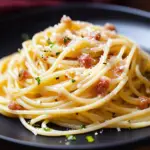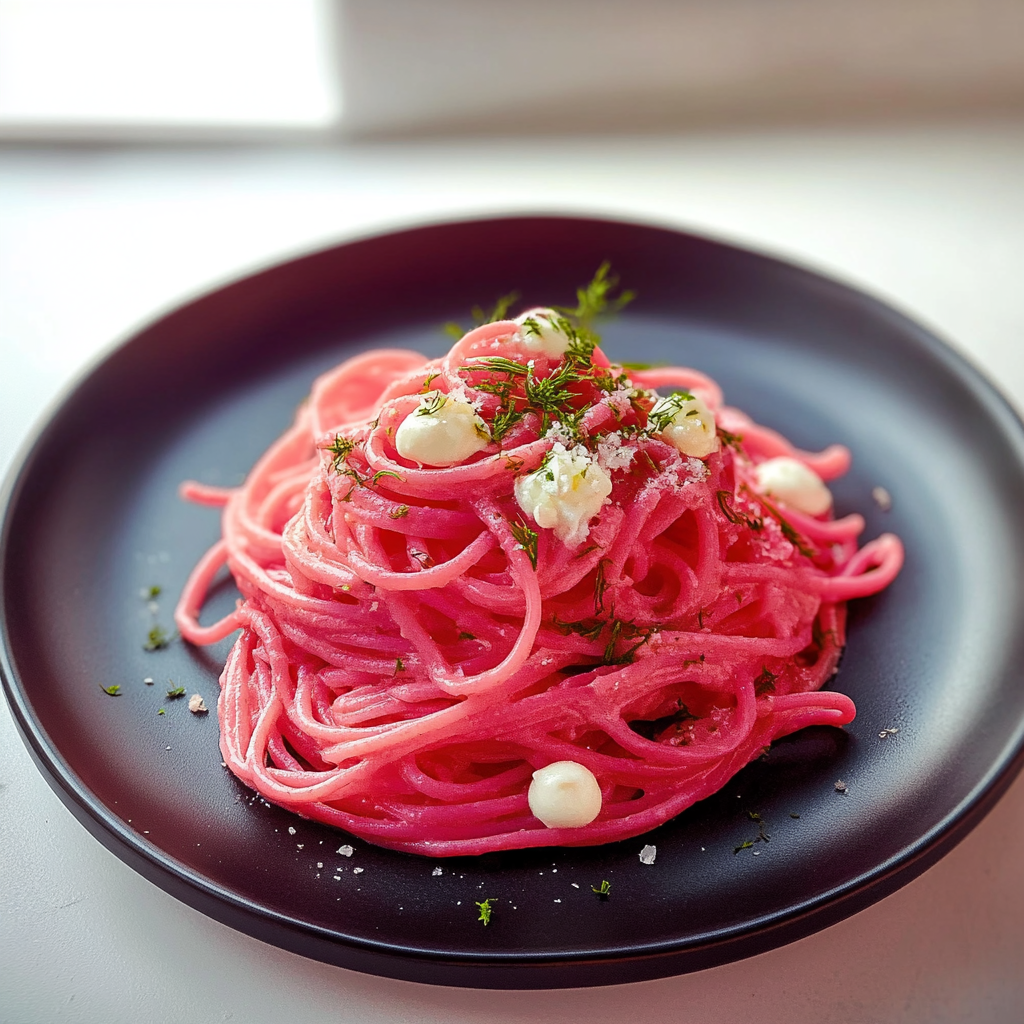Introduction and Quick Summary
If you’re a fan of Italian cuisine, you’ve likely heard of or enjoyed the classic dish known as spaghetti carbonara. This beloved pasta dish hails from Rome and is celebrated for its rich flavors and creamy texture. Made with simple yet high-quality ingredients, spaghetti carbonara is a delightful combination of al dente pasta coated in a luscious sauce made from eggs, cheese, pancetta, and pepper. It’s quick to prepare and perfect for both weeknight dinners and special occasions.
In this article, we will guide you through making the perfect spaghetti carbonara at home. Not only will we share the essential ingredients needed for this dish, but we will also provide step-by-step instructions to ensure your creation turns out flawlessly every time. Whether you’re an experienced cook or just starting out in the kitchen, you’ll find our tips easy to follow. Get ready to impress your family or guests with this authentic spaghetti carbonara that captures the essence of Italian cooking!
Main Ingredients
Spaghetti
Spaghetti forms the base of this classic dish. Typically made from durum wheat semolina, it’s essential to use high-quality pasta for the best results. You’ll need about 400 grams (14 ounces) of spaghetti for four servings. Cooking it al dente is crucial because it will continue to cook slightly when mixed with the sauce later on.
Pancetta
Pancetta adds a savory depth to your spaghetti carbonara. This Italian cured meat is typically made from pork belly and has a rich flavor profile. You’ll need around 150 grams (5 ounces) of pancetta cut into small cubes. When cooked until crispy, it complements the creamy sauce beautifully.
Eggs
Eggs are what give spaghetti carbonara its signature creaminess without using heavy cream. For this recipe, use three large eggs; two should be whole eggs while one should be just the yolk. This combination creates a smooth sauce that clings perfectly to the pasta.
Pecorino Romano Cheese
Pecorino Romano cheese is a salty sheep’s milk cheese that enhances the flavor of your dish significantly. Grate about 100 grams (3.5 ounces) of this cheese for mixing into the sauce as well as for garnishing before serving. Its sharpness balances well with the richness of the pancetta.
Black Pepper
Freshly cracked black pepper adds warmth and spice to your carbonara. Use it generously throughout the cooking process; approximately one teaspoon should suffice for seasoning during preparation. Ensure you have extra pepper on hand for sprinkling over individual servings.

How to Prepare Spaghetti Carbonara
Step 1: Cook the Pasta
Begin by bringing a large pot of salted water to a boil over high heat. Once boiling, add in your 400 grams of spaghetti and cook according to package instructions until al dente—this usually takes around 8-10 minutes depending on thickness. Stir occasionally to prevent sticking.
While waiting for the pasta to cook, prepare your other ingredients so everything is ready when needed.
Once cooked, reserve about one cup of pasta water before draining it in a colander. This starchy water will help adjust your sauce’s consistency later on if necessary.
Step 2: Cook Pancetta
In a large skillet over medium heat, add your 150 grams of diced pancetta. Cook it until golden brown and crispy—this should take about 5-7 minutes. Make sure you stir frequently so that it cooks evenly without burning.
When done cooking, remove the skillet from heat but keep it warm while you prepare your egg mixture and combine everything later.
Step 3: Prepare Egg Mixture
In a mixing bowl, whisk together two whole eggs and one egg yolk until well combined—aim for a smooth consistency without any lumps remaining. Gradually blend in approximately 100 grams of grated Pecorino Romano cheese along with freshly cracked black pepper to taste; this should create a thick paste-like texture.
Be careful not to overmix as you want some air left in there for creaminess! Set this bowl aside until it’s time to combine with cooked pasta.
Step 4: Combine Everything
After you’ve cooked your spaghetti and pancetta separately as instructed above—it’s time to bring all components together! In the same skillet where you’ve cooked pancetta (don’t forget about that rendered fat), add drained spaghetti directly into it while still warm over low heat.
Quickly pour in egg-cheese mixture before tossing rapidly—this technique avoids scrambling those precious eggs! If needed at any point during mixing process—you can add small amounts reserved pasta water until desired creaminess achieved; remember though—it shouldn’t be soupy!
Step 5: Serve Immediately
Once everything has melded beautifully into one cohesive dish—remove from heat right away! Spoon generous portions onto plates or bowls before finishing each serving off with extra grated Pecorino Romano cheese along with more freshly cracked black pepper if desired.
Serve immediately while hot for optimal texture; reheating can lead sauces becoming gummy rather than delightfully creamy!

Serving and Storing Tips
Serving Suggestions
Spaghetti carbonara is best served fresh right after preparation; however there are still ways you can elevate its presentation! Garnish each plate generously with additional grated Pecorino Romano cheese alongside freshly cracked black pepper for an eye-catching finish that also packs flavor punch!
Consider pairing it with garlic bread or a light side salad dressed simply with olive oil & vinegar alongside sparkling water or crisp white wine enhance overall dining experience too!
Storage Instructions
If you find yourself with leftovers (though it’s unlikely!), store them properly within an airtight container in refrigerator—a good practice helps retain flavors longer! Consume within two days maximum while following safety guidelines concerning food storage temperatures below forty degrees Fahrenheit (4 degrees Celsius).
To reheat—simply place desired portion into microwave-safe bowl before covering loosely using damp paper towel ensuring moisture retained during warming up process; alternatively reheat gently over stovetop drizzled lightly again with reserved pasta water if necessary avoiding drying out further!
By following these detailed instructions along with simple yet flavorful ingredient choices—you’ll master delicious homemade spaghetti carbonara that’ll leave eaters craving more every single time! Enjoy creating culinary delights right at home!
Mistakes to avoid
One common mistake when preparing spaghetti carbonara is using the wrong type of pasta. While any pasta may seem suitable, traditional recipes specifically call for spaghetti. Other varieties like fettuccine or penne can alter the dish’s authentic texture and flavor profile. Sticking to spaghetti allows the sauce to cling better, creating a more harmonious dish.
Another frequent error is overcooking the pasta. To achieve that ideal al dente texture, you should cook the spaghetti just until it is tender but still firm to the bite. Overcooked pasta becomes mushy and loses its ability to hold onto the sauce, resulting in a less enjoyable meal. Always taste a strand before draining to ensure it’s cooked perfectly.
Using cream in your carbonara is another significant blunder. Authentic spaghetti carbonara relies on eggs and cheese for its creamy consistency. Adding cream alters the traditional recipe and can overpower the classic flavors of guanciale and Pecorino Romano cheese. Stick to eggs and cheese for that rich, velvety texture without compromising authenticity.
Inadequate seasoning can also ruin your dish. While guanciale adds saltiness, it’s essential to season your water adequately when cooking pasta. A lack of salt can make the entire dish bland, overshadowing the other flavors in the carbonara. Make sure to taste as you go, adjusting seasoning as needed.
Lastly, neglecting to mix your sauce off the heat is crucial. After combining your egg and cheese mixture with the hot pasta, remove it from direct heat to prevent scrambling the eggs. This step ensures you get that smooth, creamy sauce without any curdled bits ruining your dish.

Tips and tricks
When making spaghetti carbonara, start by preparing all your ingredients in advance. This includes chopping guanciale into small pieces and grating Pecorino Romano cheese. Having everything ready helps you work quickly during cooking, ensuring that you maintain control over textures and temperatures.
Another useful tip is to reserve some pasta water before draining your spaghetti. This starchy water can be incorporated into your sauce if it turns out too thick or dry. The additional moisture helps create a more luscious sauce while maintaining flavor integrity.
To achieve a perfectly creamy sauce without scrambling eggs, consider tempering them first. You can do this by slowly adding a bit of hot pasta water into your egg mixture while whisking continuously before combining it with the pasta. This gradual heating method helps avoid curdling and results in a silkier texture.
Timing is another important factor when making spaghetti carbonara. Start cooking your guanciale while boiling water for pasta simultaneously. By managing both tasks effectively, you’ll have everything ready at about the same time, ensuring optimal freshness and flavor.
Don’t forget about garnish! A sprinkle of freshly cracked black pepper adds not only visual appeal but also enhances flavor depth in spaghetti carbonara. Consider adding an extra layer of flavor with freshly chopped parsley or additional grated cheese for presentation.
Lastly, serve immediately after preparing for maximum enjoyment. Spaghetti carbonara tastes best fresh off the stove while it’s still warm and creamy. If left sitting too long, it can become clumpy as the sauce thickens upon cooling.
Suggestions for spaghetti carbonara
If you’re looking to switch things up with your spaghetti carbonara without losing its core essence, consider trying pancetta as an alternative to guanciale. While guanciale offers a unique flavor profile due to its higher fat content, pancetta will deliver similar results in terms of texture and overall taste while being more accessible in many grocery stores.
For those who prefer a vegetarian option, try substituting traditional meat components with sautéed mushrooms or smoked tempeh. These alternatives introduce robust flavors while maintaining satisfying textures that complement the creamy sauce beautifully.
Experimenting with different cheeses can also yield delightful results; instead of solely relying on Pecorino Romano cheese, try mixing it with Parmigiano-Reggiano for added complexity in flavor profiles. This blend elevates your dish while remaining true to its Italian roots.
Consider incorporating seasonal vegetables like asparagus or peas into your spaghetti carbonara for an added burst of color and nutrition. Adding these veggies not only enhances visual appeal but also provides fresh elements that balance well with the rich sauce.
If you’re feeling adventurous, add spices like red pepper flakes or garlic powder to bring some heat into your dish without overshadowing its classic flavors. Just remember moderation is key—too much spice could overpower other ingredients’ subtleties.
Lastly, always serve alongside crusty bread or a side salad for a complete meal experience! Crusty bread works wonders in soaking up leftover sauce while offering textural contrast against creamy pasta dishes like spaghetti carbonara.

FAQs
What is authentic spaghetti carbonara?
Authentic spaghetti carbonara consists of simple yet high-quality ingredients: spaghetti pasta, guanciale (cured pork cheek), Pecorino Romano cheese, eggs, black pepper, and salt. The beauty lies in how these elements come together without unnecessary additions like cream or vegetables; each component plays an essential role in achieving that characteristic flavor profile we love so much!
Can I use bacon instead of guanciale?
While bacon is often used as a substitute due to availability issues outside Italy—it’s essential to note that guanciale has distinct flavors resulting from its higher fat content compared to regular bacon cuts! If opting for bacon instead—look for options labeled “thick-cut” so they mimic some characteristics found in traditional guanciale dishes!
How do I store leftover spaghetti carbonara?
To store leftover spaghetti carbonara properly—place it into an airtight container once cooled down completely! When reheating—the best method involves using low heat on stovetops along with added moisture (like reserved pasta water)—this prevents drying out while preserving original creaminess!
Can I make spaghetti carbonara gluten-free?
Absolutely! You can easily substitute regular wheat-based spaghetti with gluten-free alternatives made from rice flour or legumes! The same cooking principles apply here; however—ensure you check ingredient labels carefully if adhering strictly towards gluten-free dietary needs!
What should I serve with my spaghetti carbonara?
For sides accompanying this rich dish—consider serving fresh salads dressed lightly (to balance richness) or crusty breads perfect for soaking up any leftover sauces! Both options elevate dining experiences by providing contrasting textures alongside deliciously creamy pastas!
How do I know when my pasta is al dente?
To determine whether your pasta achieves that perfect al dente state—it should feel firm yet tender when bitten into! Tasting strands occasionally during cooking ensures optimal timing before draining away excess water—you want just enough resistance without overly softening them!
Conclusion
Making flavorful spaghetti carbonara requires attention to detail throughout every step—from selecting authentic ingredients such as quality guanciale down through timing techniques ensuring perfectly cooked sauces without curdling eggs! Avoid common mistakes like overcooking pasta or utilizing cream; instead focus on achieving that classic rich texture via egg-and-cheese combinations paired harmoniously alongside well-seasoned dishes!
Emphasizing proper preparation techniques such as reserving starchy water during cooking allows flexibility when creating desired consistencies later on too—resulting in incredible meals ready swiftly within minutes! Finally remember—you have plenty of opportunities available through ingredient substitutions which maintain integrity yet enhance creativity within each plate served—so don’t shy away from experimenting occasionally!
By keeping these key points front-of-mind throughout preparation—you’ll soon impress family members (and yourself!) alike via culinary adventures unfolding right inside home kitchens everywhere!
Print
spaghetti carbonara
- Author: Sofia
- Total Time: 25 minutes
- Yield: 4 servings 1x
Description
Spaghetti Carbonara is a classic Italian pasta dish that combines creamy eggs, salty pancetta or guanciale, and Parmesan cheese for a rich and indulgent meal. With a hint of black pepper for a little kick, this dish is simple to prepare but full of delicious flavor!
Ingredients
- 12 oz spaghetti
- 4 oz pancetta or guanciale, diced
- 2 large eggs
- ½ cup grated Parmesan cheese
- ½ cup grated Pecorino Romano cheese
- Freshly ground black pepper, to taste
- Salt (for pasta water)
- 1 tbsp olive oil (for frying)
Instructions
- Cook the spaghetti in salted boiling water according to package directions until al dente. Reserve 1 cup of pasta water before draining.
- While the pasta cooks, heat olive oil in a pan over medium heat and fry the pancetta or guanciale until crispy (about 4-5 minutes).
- In a bowl, whisk together the eggs, Parmesan, Pecorino, and black pepper.
- Once the pasta is ready, add it to the pan with the pancetta. Remove the pan from heat.
- Quickly toss the pasta with the egg mixture, adding reserved pasta water a little at a time to create a creamy sauce.
- Serve immediately, garnished with more Parmesan and freshly cracked black pepper.
Notes
- Be careful not to scramble the eggs when adding them to the hot pasta. Toss quickly to create a creamy sauce.
- If you prefer a richer dish, you can add a bit of heavy cream (although this is not traditional).
- Prep Time: 10 minutes
- Cook Time: 15 minutes









